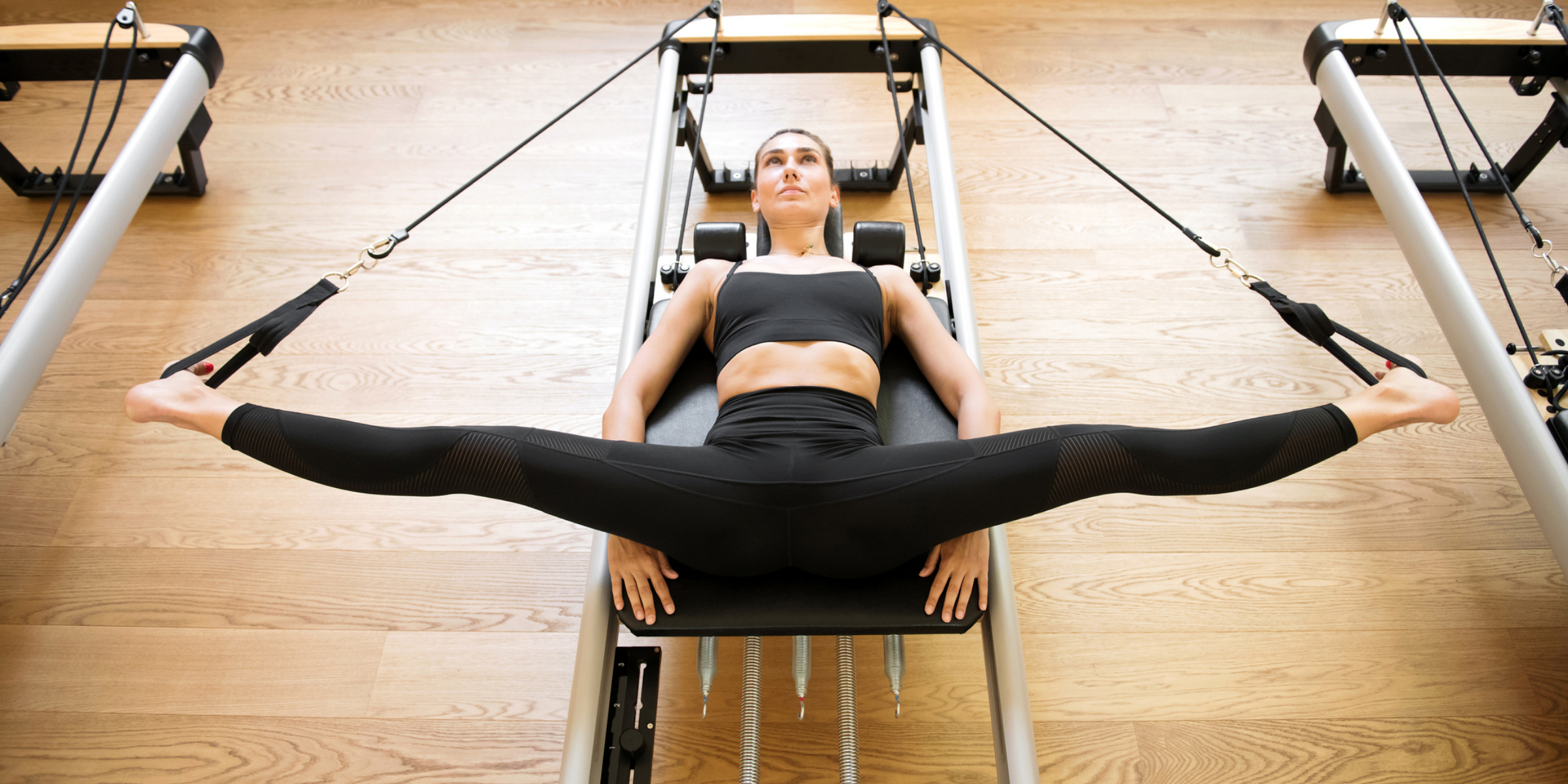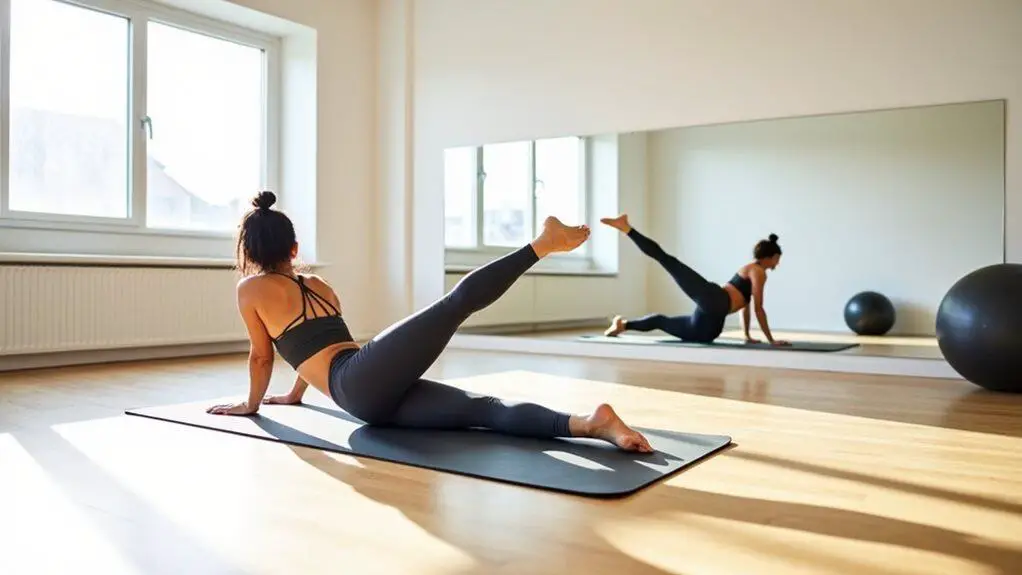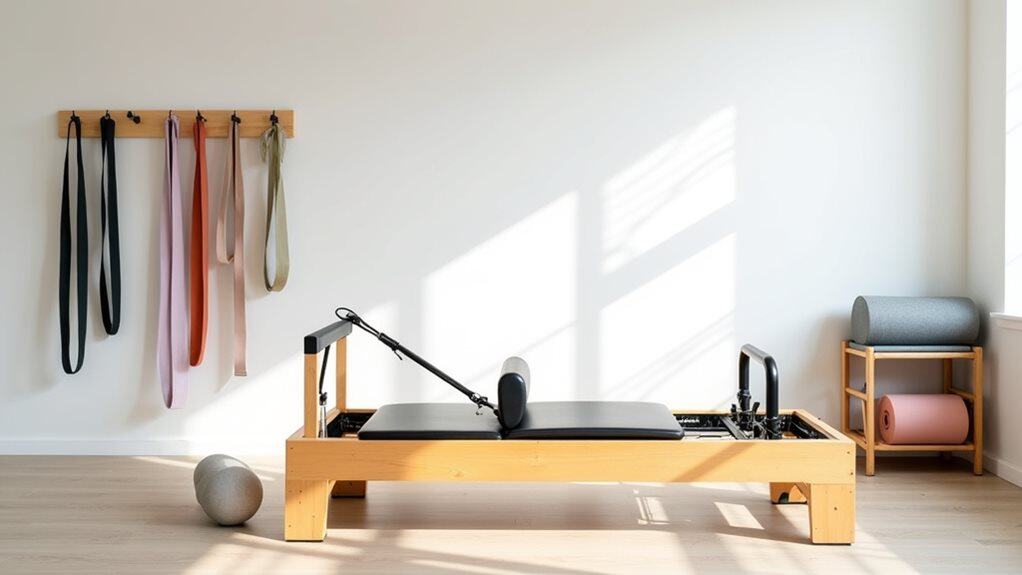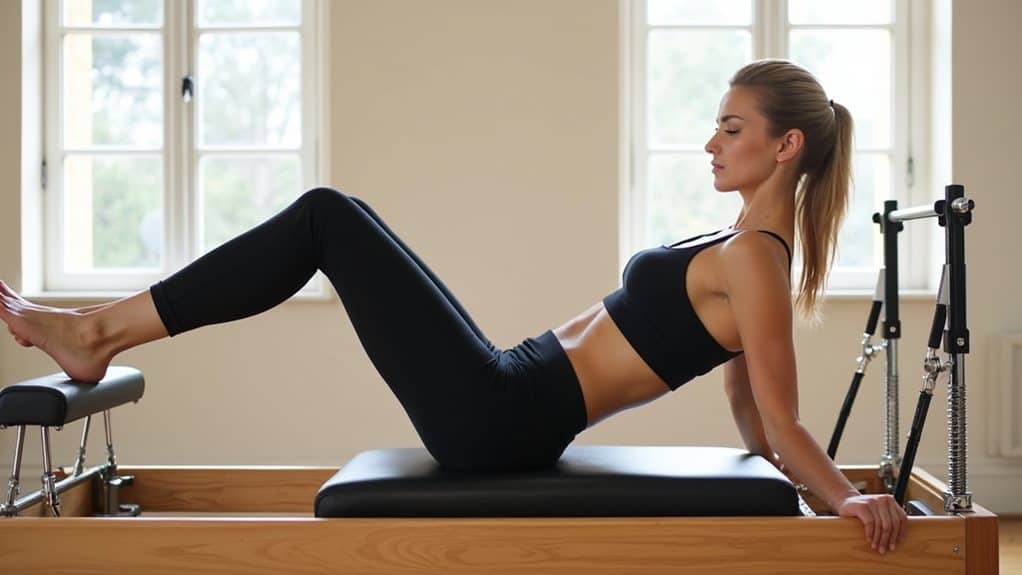You may be hesitant to invest in a Pilates reformer due to concerns about space limitations in your home or studio. However, rest assured that even if you have limited space, it is still possible to find a reformer that can fit comfortably and safely.
It’s important to understand the minimum space requirements and ideal space recommendations for a Pilates reformer, as well as tips for maximizing space efficiency to ensure a safe and effective workout.
A comfortable amount of space around a Pilates Reformer is about 6 feet by 10 feet. This allows for enough room to move the machine back and forth and perform the exercises without bumping into walls or furniture.
If you have a larger space, it can be beneficial to have even more room to allow for better movement and positioning.
Pilates reformers are an excellent tool for building strength, improving flexibility, and creating long, lean muscles. But before you can fully enjoy the benefits of a reformer workout, you need to consider how much space you’ll need.
Don’t worry, we’ve got you covered – in this article, we’ll explain the importance of space around a Pilates reformer, considerations when choosing a reformer, minimum space requirements, ideal space recommendations, safety precautions, tips for maximizing space efficiency, and even provide some Pilates reformer exercise examples.
So, whether you’re a home fitness enthusiast or a professional Pilates instructor, read on to learn more about how to make the most of your space with a Pilates reformer.
Understanding the Importance of Space Around a Pilates Reformer
Get ready to feel the freedom of movement as you understand why giving enough room to move around a Pilates Reformer is crucial for an immersive workout experience.
When it comes to Pilates, the reformer is one of the most important pieces of equipment. It’s a versatile machine that can help you achieve a wide range of movements. That’s why you need to make sure that you have enough space around it.
The first reason you need space is to set up the machine and to have room to adjust the setup based on the workout you want to do.
The importance of ventilation can’t be overstated. During a Pilates workout, your body will inevitably generate heat, which can make your surroundings feel stuffy and uncomfortable. That’s why it’s important to ensure that you have adequate ventilation in the room where your Pilates Reformer is located. This will help keep the air fresh, which can help you stay focused and energized throughout your workout.
Another important factor to consider is the impact of flooring on space requirements. The flooring around your Pilates Reformer should be smooth, even, and slip-resistant. This will help prevent accidents while you’re moving around the equipment.
Additionally, you should make sure that the flooring extends far enough out from the machine to allow you to move around freely. A good rule of thumb is to have at least three feet of space on all sides of the machine.
Now that you understand the importance of having enough space around your Pilates Reformer, it’s time to consider other factors when choosing the right machine for you. By taking the time to carefully evaluate your options, you can find a machine that meets your needs and allows you to get the most out of your Pilates workouts.
Considerations when Choosing a Pilates Reformer
When choosing a Pilates reformer, there are several important considerations you must keep in mind.
First, the size of the reformer is crucial to ensure that it fits comfortably in your workout space.
Additionally, the height of the user is also a key factor to consider, as the reformer needs to be adjusted to accommodate your body size.
Lastly, the exercises you plan to perform on the reformer will dictate the type of reformer you need, as different reformers are designed for different purposes.
Size of the Reformer
You’ll be amazed by the compact size of the reformer and how it can fit seamlessly into your home workout space. Reformer dimensions are a crucial consideration when choosing the right reformer for your home gym.
The reformer’s measurements vary depending on the brand and model, but most reformers are between 7 and 8 feet long and 2.5 to 3 feet wide. These dimensions may not seem like much, but they can take up a significant amount of space in your home gym. Therefore, it’s essential to measure your workout space to ensure that you have enough room for the reformer.
You usually can’t see it in my videos, but I have a reformer in my private studio and I have to move it around to free up space to film. Good job Pilates has improved my overall strength!
Space limitations should not deter you from getting a reformer, as there are various models available that can fit into any space. Some reformers are designed to be foldable, making them easy to store when not in use. Other models have a smaller footprint, making them ideal for people with limited workout space.
However, it’s crucial to remember that you still need enough room to perform the exercises without any restrictions. So, ensure that you have enough space around the reformer to move freely before making your purchase.
With that said, the height of the user is another critical consideration when choosing a reformer, which we will discuss in the next section.
Height of the User
Now we’re talking about the height of the user, which is a crucial factor to consider when selecting a reformer that fits like a glove.
A reformer that is too small for a tall person can make it difficult to execute the exercises properly, while a reformer that is too large for a short person can make it harder to control the movements.
When it comes to user height, it’s important to find a reformer that can be adjusted to cater to the user’s needs.
Equipment adjustments are necessary to ensure that the user’s height is accommodated for.
A reformer with adjustable foot bar and shoulder blocks can be customized to fit the user’s dimensions.
The foot bar should be positioned at a height that allows the user to perform the exercises without strain, while the shoulder blocks should be adjusted to provide support and stability.
Once the reformer has been adjusted to the user’s height, it’s time to move on to the exercises being performed.
Exercises Being Performed
Let’s dive into the exercises that can be performed on the reformer to enhance your Pilates routine. When it comes to choosing the right amount of space for your Pilates reformer, it’s important to consider the exercises you intend to perform. Proper form is crucial in Pilates, and having enough space to perform each exercise correctly is essential. Modifications can be made to accommodate different levels of skill, but having adequate space allows for optimal positioning and movement.
Breathing techniques, resistance levels, and body alignment all come into play when performing exercises on the reformer. For example, the leg press exercise requires a full range of motion, which means you’ll need more space than an exercise that involves only small movements.
It’s important to consider the resistance level you’ll be using as well, as this will affect the amount of space needed. Proper form and alignment are essential in Pilates, and having adequate space to move freely and safely is key.
Now, let’s move on to the minimum space requirements for your Pilates reformer.
Minimum Space Requirements
To ensure safe and effective workouts, it’s important to make sure you have enough room for the Pilates reformer to move freely and for you to comfortably transition between exercises. Sarah learned this lesson the hard way when she attempted to do the Long Stretch exercise too close to a wall and ended up injuring herself. Therefore, before starting your Pilates routine, take note of the minimum space requirements for the reformer.
Here are some minimum space requirements to consider when setting up your Pilates reformer:
-
The reformer should be placed in an open area with a minimum of 6 feet of space behind it and 2 feet on either side of it. This space is necessary for the carriage to move freely during exercises like the Long Stretch or Knee Stretches.
-
The ceiling should be high enough to accommodate the full length of the reformer when the footbar is raised. This is important for exercises like the Overhead that require the footbar to be raised above the head.
While space limitations may be a concern, there are alternative reformer options available that require less space. For example, the Pilates Springboard, which is a wall-mounted unit, only requires around 4 feet of horizontal space and 8 feet of vertical space. It can be used for most of the same exercises as the traditional reformer, making it a great option for those with limited space.
Having the minimum space requirements in place will ensure that you can perform a variety of Pilates exercises safely and effectively. In the next section, we’ll discuss ideal space recommendations for the reformer, so you can make the most out of your Pilates routine.
Safety Precautions
Now that you know the ideal space recommendations for a Pilates Reformer, let’s talk about safety precautions. Safety measures are crucial when using any type of exercise equipment, and the Pilates Reformer is no exception.
Before each use, it’s important to check the equipment for any signs of wear and tear, such as frayed cables or loose bolts. If any issues are found, don’t use the machine until it’s been properly repaired.
In addition to equipment maintenance, proper use of the Pilates Reformer is essential for safety. Always make sure to use the machine as instructed by a certified Pilates instructor. Using incorrect form or attempting advanced exercises without proper training can result in injury.
It’s also important to start with beginner-level exercises and gradually work your way up to more challenging workouts.
By following these safety measures, you can ensure a safe and effective Pilates Reformer workout. In the next section, we’ll discuss tips for maximizing space efficiency. With these tips, you can make the most of your workout space without compromising safety or comfort.
Tips for Maximizing Space Efficiency
Get the most out of your Pilates workout and feel accomplished with these space-saving tips. Maximizing benefits and space-saving solutions can be achieved even in limited spaces.
One of the easiest ways to maximize space is to choose a reformer that fits your space. Reformer sizes differ, so it’s essential to measure your space and choose a model that fits perfectly.
Another space-saving solution is to choose a reformer with a folding option. It is perfect for those who have limited space in their homes or studios. A folding reformer can be easily stored away when not in use, giving you more room to move around.
You could also opt for a wall-mounted reformer. This type of reformer attaches to the wall, freeing up floor space and allowing you to perform your Pilates exercises without worrying about space.
The key is to ensure that you have enough room to move around freely and perform your exercises without any hindrance. Clear the area of any clutter and unnecessary items that may affect your movement.
With these space-saving tips, you can maximize your Pilates workout and achieve your fitness goals without worrying about space limitations.
Now that you’ve learned how to maximize space for your Pilates workout, it’s time to put it into practice. Here are some Pilates reformer exercise examples that you can do in your limited space.
Pilates Reformer Exercise Examples
You’ll love these Pilates reformer exercise examples – they’re perfect for fitting in a quick workout in your limited home or studio space. And who doesn’t want to tone and strengthen their body with some fun, challenging moves?
Pilates reformer variations are endless, and each exercise targets different muscle groups. Here are just a few examples to get you started:
-
The Hundred: This classic Pilates exercise targets your abs and arms. Lie on your back with your legs in a tabletop position and your arms by your sides. Lift your head and shoulders off the mat, and pump your arms up and down while inhaling for five counts and exhaling for five counts.
-
Footwork: This exercise is great for strengthening your legs and glutes. Sit on the reformer with your feet on the footbar and your hands on the shoulder blocks. Push the footbar away from you and then slowly bring it back towards you while keeping your legs straight.
-
Elephant: The elephant exercise works your core, arms, and legs. Stand facing the footbar with your hands on it and your feet on the carriage. Push the carriage back while keeping your legs straight and your back flat. Then, pull the carriage back in while bending your knees and lifting your hips.
The benefits of reformer exercises are numerous. They improve flexibility, balance, and posture, while also toning and strengthening your muscles. Plus, the resistance provided by the springs on the reformer adds an extra challenge to each exercise.
Incorporating Pilates reformer exercises into your workout routine is a great way to maximize your space efficiency while still achieving a full-body workout. With so many variations to choose from, you’ll never get bored.
In the next section, we’ll discuss some final thoughts on space requirements around a Pilates reformer.
Space Requirements Around a Pilates Reformer
Make sure to keep in mind the necessary area around your Pilates reformer to ensure a safe and effective workout. Space optimization is key when it comes to setting up your Pilates reformer. You want to have enough room to move around and perform the exercises without feeling cramped or restricted. Furniture arrangement is also important to consider, as you don’t want any obstacles or hazards in your workout space.
To help you visualize the amount of space required, take a look at the table below. This table outlines the minimum amount of space needed for a typical Pilates reformer workout. Keep in mind that these are general guidelines and may vary depending on the specific exercises you are performing.
| Exercise | Minimum Space Required |
|---|---|
| Footwork | 6′ x 6′ |
| Long Stretch | 8′ x 6′ |
| Short Box Series | 8′ x 8′ |
| Elephant | 10′ x 6′ |
With this table, you can see that the space needed for Pilates reformer exercises can vary. However, by optimizing your space and arranging your furniture in a way that allows for maximum movement, you can ensure a safe and effective workout.
Creating a Pilates reformer workout space that is functional and safe requires careful consideration of the furniture arrangement and space optimization. By taking the time to plan out your workout area and ensuring you have enough space around your reformer, you can achieve a more effective and enjoyable workout experience. Remember to always prioritize safety and give yourself enough room to move around freely.
Conclusion
Now that you understand the importance of space around a Pilates reformer, you can make an informed decision on which one to purchase for your home gym. Remember to consider the size of the reformer, your own body size, and the space you have available before making a final decision.
Additionally, it’s important to follow safety precautions and tips for maximizing space efficiency to ensure a safe and effective Pilates workout. By doing so, you can enjoy the many benefits of Pilates, such as improved flexibility, balance, and core strength.
With the right amount of space and equipment, you can achieve your fitness goals and feel confident in your Pilates practice.




